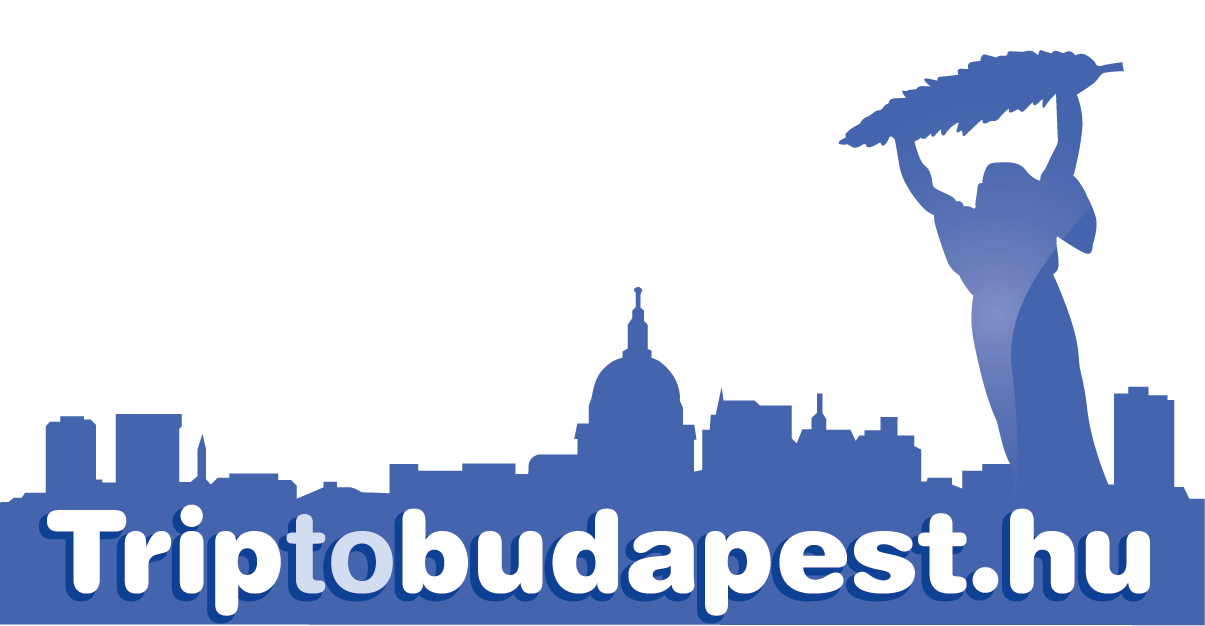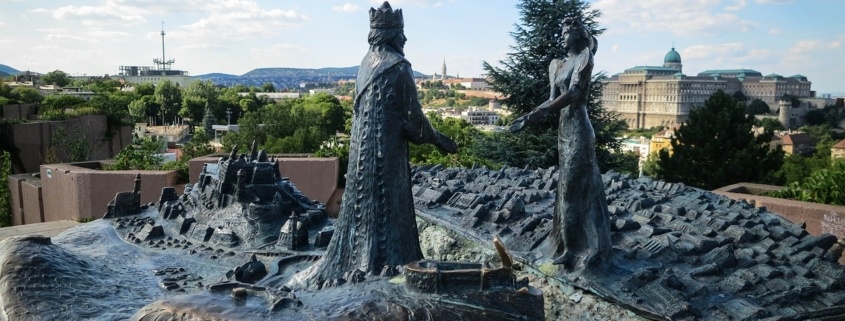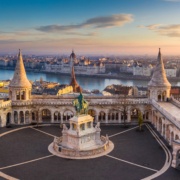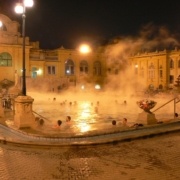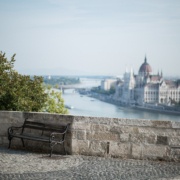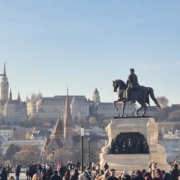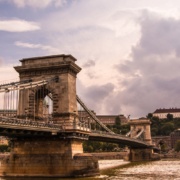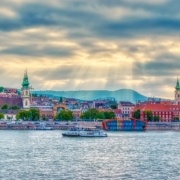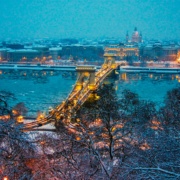13 Unique Memorials and Statues in Budapest
Welcome to Budapest, a city adorned with a rich tapestry of statues and memorials that tell tales of its past. In this exploration, we’ll delve into 13 unique sculptures that stand as silent storytellers, each with its own historical significance and cultural resonance. These memorials offer insights into local culture, history, and artistic expression. We believe their presence often enriches the overall journey for all those travelers seeking a deeper connection with Budapest. So let’s see our favorite statues in Budapest:
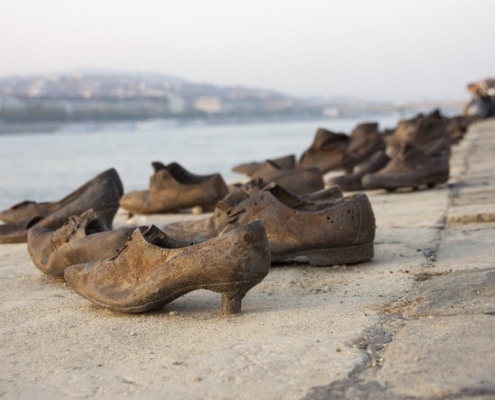
Shoes on the Danube
On the edge of the Danube embankment, a short walk from the Parliament, you’ll discover a collection of 60 pairs of shoes sculpted in bronze—representing a variety of styles. This poignant installation marks the site where Jewish men, women, and children were executed during the winter of 1944-45 by the Arrow Cross Party Militiamen. Before facing their tragic fate in the river, victims were compelled to remove their shoes, as these items held significant value during that time. The 60 pairs of shoes are positioned along the riverside, serving as a solemn memorial to commemorate the 60th anniversary of the Holocaust. During our Free Budapest Tour, we make a stop at this meaningful site, providing an authentic and personal summary of Budapest’s Holocaust history in just a few minutes. Take a moment to gaze at the shoes and the river beyond. This site stands as a powerful reminder of the atrocities of the past and a call to ensure that such horrors are never repeated.
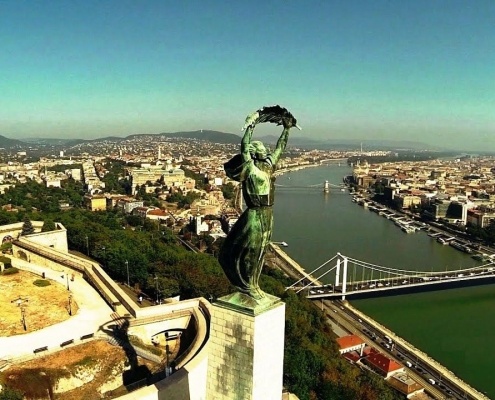
Liberty Statue on Gellért Hill
Situated atop Gellért Hill, visible from every downtown vantage point, this statue was erected in 1947. It serves as a poignant reminder of the Soviet liberation of Hungary during World War II, marking the end of Nazi Germany’s occupation. The bronze statue, standing at 14 meters, graces a 26-meter pedestal, holding a palm leaf. The monument’s model was Erzsébet Gaál, a 28-year-old woman discovered on the streets by Zsigmond Kisfaludi Strobl. The statue underwent a transformation in 1992 during a cultural event when the woman bearing the palm branch was covered in a white shroud for a few days. This evolution marked the statue’s shift from the spirit of Communism over the city to a ghostly presence.
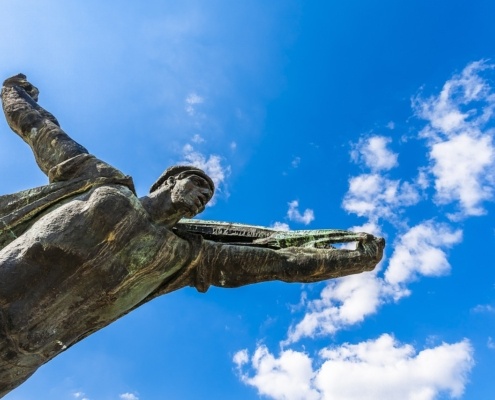
Statues in Memento Park
Memento Park, located outside Budapest’s center, is a must-visit! This Eastern European gem showcases political statues that once adorned Budapest’s streets from 1947 to 1988. With the fall of European communism in 1989, the statues in Memento Park underwent a transformative fate. As Central and Eastern Europeans liberated themselves from oppressive ideologies, symbols like Marx, Engels, Lenin, and Hungarian party figures lost their authority. The swift removal of these symbols across Eastern Europe within weeks, if not days, consigned them to history’s trash heap. Over 30 years later, memories of the dark days of communism persist, ensuring the lessons are not forgotten. In Budapest, a distinctive approach emerged. An entrepreneur gathered the city’s discarded statues, creating Memento Park—a curated display in a vast field on the outskirts. This unconventional park now stands as a testament to human resilience and a tangible reminder of the ideological shift shaping Budapest’s cultural landscape. During the Free Communism Tour, we introduce socialist realist art and explore how these statues affected our childhood during communism.
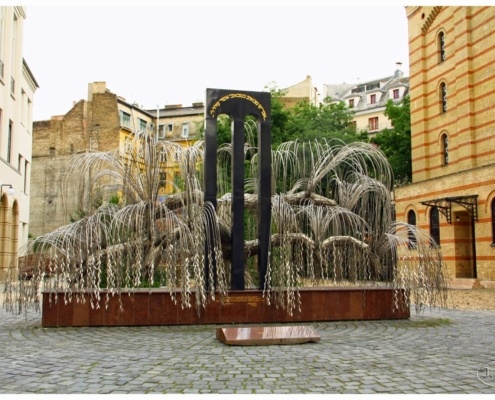
Weeping Willow Tree Memorial
In the courtyard of the Dohany Street Great Synagogue, there stands an iron weeping willow tree known as the Tree of Life. This poignant structure, adorned with 6,000 leaves, serves as a solemn reminder of the approximately 600,000 victims of the Hungarian Holocaust. Beyond Jewish individuals, the victims include Roma, gay people, and others. Most leaves bear engraved names, inviting visitors to touch them, and fostering contemplation about the innocent lives lost. The park’s construction was funded by a renowned American actor from the 1950s, originally named Bernard Schwartz. Born to Hungarian Jewish parents who had left Hungary before World War II, he adopted the popular actor name Tony Curtis and achieved legendary status in America, boasting a career that spanned six decades. During our Free Jewish District Tour, we make a stop at this meaningful site, providing an authentic and personal summary of Budapest’s Holocaust history in just a few minutes.
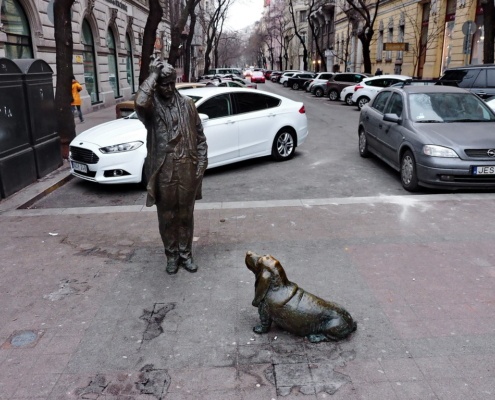
Detective Columbo Statue
Detective Columbo, portrayed by Peter Falk, is honored with a statue located in Falk Miksa Street in Budapest. The sculpture, erected in 2014, captures the iconic pose, complete with Columbo’s trademark raincoat and cigar. Peter Michael Falk, born in New York City to Russian immigrant parents, proudly traced his ancestry to Russia, Poland, Czechia, and Hungary through his grandparents. Interestingly, Columbo’s beloved basset hound never officially received a name. When the detective first rescued the dog, he toyed with the names Fido or Beethoven but ultimately settled on simply referring to his faithful companion as Dog or You.
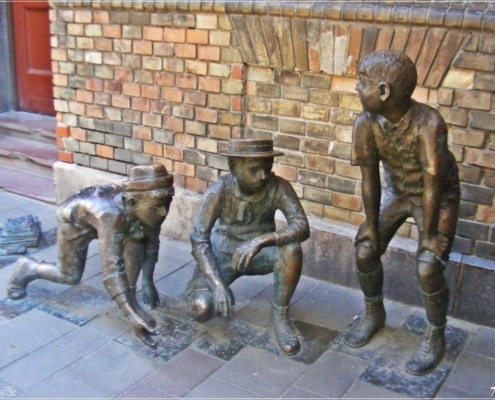
Paul Street Boys
This bronze sculpture in Budapest’s Práter Street brings to life a scene from Ferenc Molnár’s classic novel, “The Paul Street Boys.” This tale is about the schoolboys’ adventures in Budapest’s Józsefváros neighborhood in 1889. The sculpture vividly portrays a moment from the story known as ‘einstand,’ where boys returning from school play marbles. Two teams are engrossed in the game, while a third, seemingly indifferent, secretly watches with envy. Standing before these bronze figures, you might feel an urge to join the marble game. If you find these statues intriguing, consider reading “The Paul Street Boys.” The novel promises an engaging journey through the characters and history that inspired this evocative sculpture.
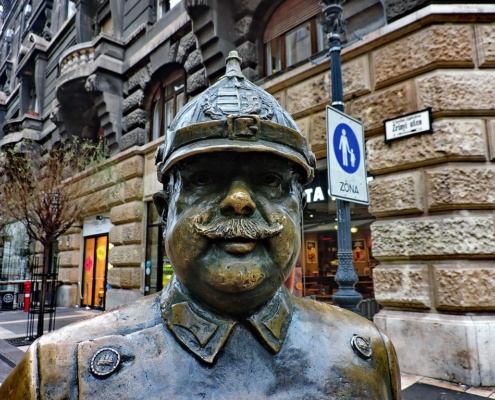
The Fat Policeman
This life-sized bronze sculpture portrays a calm 19th-century policeman overseeing order and traffic on the street. The Fat Policeman statue is located approximately 150 meters west of St. Stephen’s Basilica, towards the Danube River. What sets this statue apart is its notable belly, widely regarded as one of the most touched bellies in Budapest. The shiny, round belly is a playful representation of Hungary’s affection for hearty, substantial foods like gulyás (goulash) or lángos (deep-fried flatbread). According to a popular legend, rubbing his belly ensures you’ll enjoy delicious food in Budapest. Don’t miss the chance to encounter this iconic statue as you stroll near the cathedral—it’s a unique and charming part of the Budapest experience. Take our daily Free Budapest Tours to learn about traditional Hungarian food and discover the most authentic places to eat in Budapest.
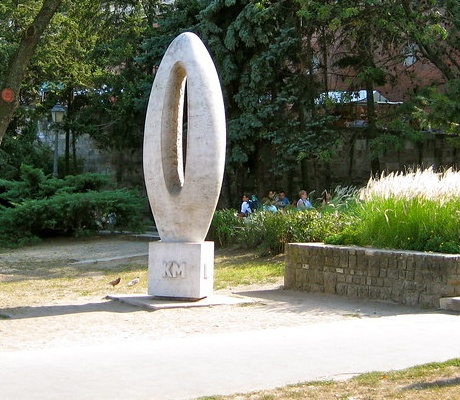
Zero Kilometer Stone
Situated by the famous Budapest Funicular, the Zero Kilometer Stone is a three-meter-high limestone monument with a “KM” inscription, marking the starting point for all road distances in Hungary. Created by sculptor Miklós Borsos, this cool-looking monument was unveiled in 1975, replacing the original destroyed during World War II. Find it easily on Clark Adam Ter, near the western end of Széchenyi Chain Bridge.
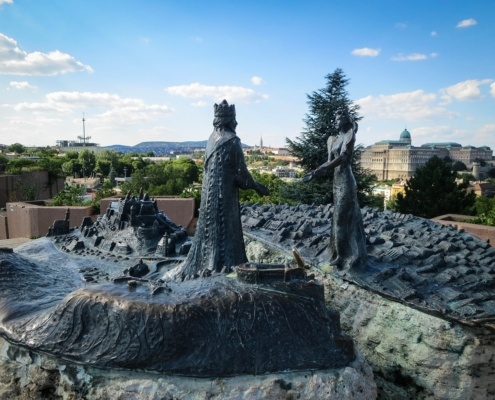
The Garden of Philosophers
This garden offers a peaceful retreat away from the bustling city, nestled on the side of Gellért Hill. The statues within the circle symbolize the belief in “better mutual understanding” with representations of Jesus, Buddha, Lao Tse, Abraham, and Ekhnaton. Additionally, statues of Gandhi, Bodi Dharma, and Saint Francis stand just outside the circle. The dramatic symbolism beautifully conveys the idea that various cultures and religions can coexist harmoniously. As you appreciate the tranquil surroundings, take in a spectacular view of Buda Castle Hill from the garden.
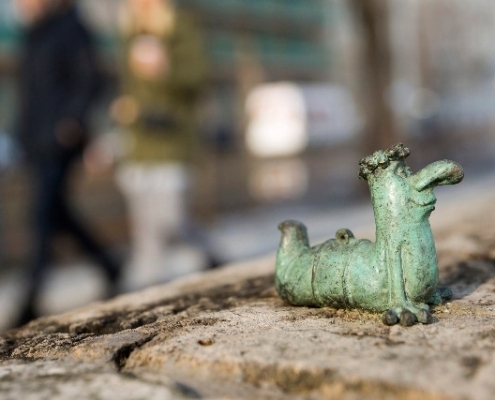
Mini Statues of Kolodko
Budapest conceals nearly 30 miniature statues, skillfully placed throughout the city by Mihajlo Kolodko, a Ukrainian artist with Hungarian roots. You must keep your eyes peeled to spot these hidden gems amid the hustle and bustle of the busy streets and squares. Each mini-statue carries a meaningful story, often drawing inspiration from Hungarian folklore and history in Kolodko’s distinctive style. Join our daily Free Budapest Tours to discover the fascinating tales behind these statues.
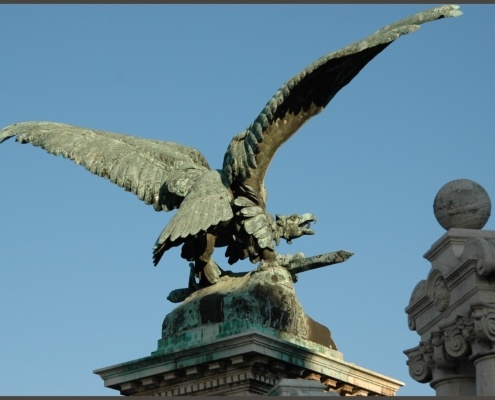
Turul Statue
Discover the bronze turul bird statue on our Free Buda Castle Tour, close to the Royal Palace. Find it near the Habsburg steps and Habsburg Gate on the east side. The turul bird is a key figure in an ancient Hungarian folktale. According to the legend, it played a role in Árpád, the chieftain of the Magyar tribes, leading the Hungarians into the Carpathian Basin around 896 AD. The bird dropped a sword here in Budapest, marking the Hungarian homeland. Besides the interesting story, enjoy a fantastic view of the Danube and the Pest side of the city from this spot.
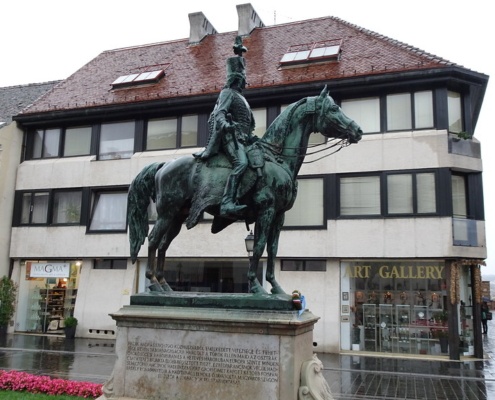
Hadik András Statue
While walking from Matthias Church toward the Hospital in the Rocks, you’ll come across the statue of Hussar General András Hadik, mounted on his horse. Erected in 1937, this bronze statue pays homage to Hadik, a Hungarian Hussar general in the Habsburg military during the 19th century, known for his successful military campaigns. An intriguing detail awaits those who closely examine the statue: the horse’s testicles are shiny yellow, standing out from the patina covering the rest of the sculpture.
During the Communist era, engineering students residing in the nearby dormitory had a unique tradition of polishing the horse’s testicles on the morning of challenging exams, believing it brings them good luck. There’s even a playful suggestion that touching the balls imparts students with extra skills in bed. Join our daily Free Buda Castle Tours to unravel the truth behind these amusing stories.
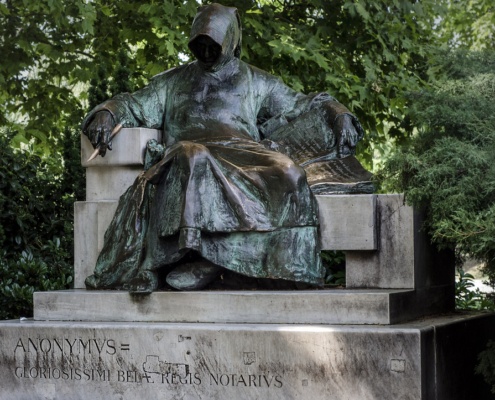
Anonymus
This enigmatic and almost wizard-like statue is situated in Budapest City Park near Vajdahunyad Castle behind Heroes’ Square. The real Anonymous lived in the 13th century, and his true identity remains appropriately unknown. He is believed to have served as a notary to Béla III of Hungary, composing the chronicle “Gesta Hungarorum” (Deeds of the Hungarians).
The intriguing statue depicts a hooded figure titled Anonymous, the unknown chronicler, holding a pen in the left hand. Visiting writers often rub the pen, seeking inspiration for travel blogs or hoping to bring good luck to their studies. If you are a travel blogger and find success in your writing after touching the pen, consider sending your donations to your tour guides in Budapest.
